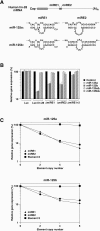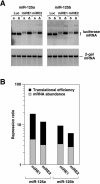Micro-RNA regulation of the mammalian lin-28 gene during neuronal differentiation of embryonal carcinoma cells
- PMID: 16227573
- PMCID: PMC1265813
- DOI: 10.1128/MCB.25.21.9198-9208.2005
Micro-RNA regulation of the mammalian lin-28 gene during neuronal differentiation of embryonal carcinoma cells
Abstract
Vertebrate genomes each encode hundreds of micro-RNAs (miRNAs), yet for few of these miRNAs is there empirical evidence as to which mRNA(s) they regulate. Here we report the identification of human lin-28 mRNA as a regulatory target of human miR-125b and its homolog miR-125a. Studies of miR-125b function in mouse P19 embryonal carcinoma cells induced to develop into neurons suggest a role for this regulatory miRNA in mammalian neuronal differentiation, since its increased concentration in these cells contributes to lin-28 downregulation. Within the lin-28 3' untranslated region (UTR) are two conserved miRNA responsive elements (miREs) that mediate repression by miR-125b and miR-125a. Simultaneous deletion of both miREs renders the lin-28 3' UTR almost completely insensitive to these miRNAs, indicating that these two miREs are the principal elements in the lin-28 3' UTR that respond to miR-125. At the 3' end of each element is an adenosine residue that makes a significant contribution to function irrespective of its complementarity to the 5'-terminal nucleotide of miR-125. By contrast to most earlier reports of gene repression by other miRNAs that are imperfectly complementary to their targets, lin-28 downregulation by miR-125 involves reductions in both translational efficiency and mRNA abundance. The decrease in the mRNA concentration is achieved by a posttranscriptional mechanism that is independent of the inhibitory effect on translation.
Figures











Similar articles
-
Expression profiling of mammalian microRNAs uncovers a subset of brain-expressed microRNAs with possible roles in murine and human neuronal differentiation.Genome Biol. 2004;5(3):R13. doi: 10.1186/gb-2004-5-3-r13. Epub 2004 Feb 16. Genome Biol. 2004. PMID: 15003116 Free PMC article.
-
MicroRNAs regulate synthesis of the neurotransmitter substance P in human mesenchymal stem cell-derived neuronal cells.Proc Natl Acad Sci U S A. 2007 Sep 25;104(39):15484-9. doi: 10.1073/pnas.0703037104. Epub 2007 Sep 13. Proc Natl Acad Sci U S A. 2007. PMID: 17855557 Free PMC article.
-
Regulation of the MIR155 host gene in physiological and pathological processes.Gene. 2013 Dec 10;532(1):1-12. doi: 10.1016/j.gene.2012.12.009. Epub 2012 Dec 14. Gene. 2013. PMID: 23246696 Review.
-
Development of a dual-luciferase reporter system for in vivo visualization of MicroRNA biogenesis and posttranscriptional regulation.J Nucl Med. 2008 Feb;49(2):285-94. doi: 10.2967/jnumed.107.042507. Epub 2008 Jan 16. J Nucl Med. 2008. PMID: 18199619
-
The molecular mechanism of translational control via the communication between the microRNA pathway and RNA-binding proteins.RNA Biol. 2015;12(9):922-6. doi: 10.1080/15476286.2015.1073436. RNA Biol. 2015. PMID: 26274611 Free PMC article. Review.
Cited by
-
Deadenylation is a widespread effect of miRNA regulation.RNA. 2009 Jan;15(1):21-32. doi: 10.1261/rna.1399509. Epub 2008 Nov 24. RNA. 2009. PMID: 19029310 Free PMC article.
-
To polyadenylate or to deadenylate: that is the question.Cell Cycle. 2010 Nov 15;9(22):4437-49. doi: 10.4161/cc.9.22.13887. Epub 2010 Nov 15. Cell Cycle. 2010. PMID: 21084869 Free PMC article. Review.
-
MiR-125b acts as an oncogene in glioblastoma cells and inhibits cell apoptosis through p53 and p38MAPK-independent pathways.Br J Cancer. 2013 Nov 26;109(11):2853-63. doi: 10.1038/bjc.2013.672. Epub 2013 Oct 29. Br J Cancer. 2013. PMID: 24169356 Free PMC article.
-
Correlation of expression profiles between microRNAs and mRNA targets using NCI-60 data.BMC Genomics. 2009 May 12;10:218. doi: 10.1186/1471-2164-10-218. BMC Genomics. 2009. PMID: 19435500 Free PMC article.
-
MicroRNA expression pattern of undifferentiated and differentiated human embryonic stem cells.Stem Cells Dev. 2007 Dec;16(6):1003-16. doi: 10.1089/scd.2007.0026. Stem Cells Dev. 2007. PMID: 18004940 Free PMC article.
References
-
- Ambros, V., and H. R. Horvitz. 1984. Heterochronic mutants of the nematode Caenorhabditis elegans. Science 226:409-416. - PubMed
-
- Berezikov, E., V. Guryev, J. van de Belt, E. Wienholds, R. H. Plasterk, and E. Cuppen. 2005. Phylogenetic shadowing and computational identification of human microRNA genes. Cell 120:21-24. - PubMed
-
- Brewer, G. J., J. R. Torricelli, E. K. Evege, and P. J. Price. 1993. Optimized survival of hippocampal neurons in B27-supplemented Neurobasal, a new serum-free medium combination. J. Neurosci. Res. 35:567-576. - PubMed
Publication types
MeSH terms
Substances
Grants and funding
LinkOut - more resources
Full Text Sources
Other Literature Sources
Molecular Biology Databases
Research Materials
